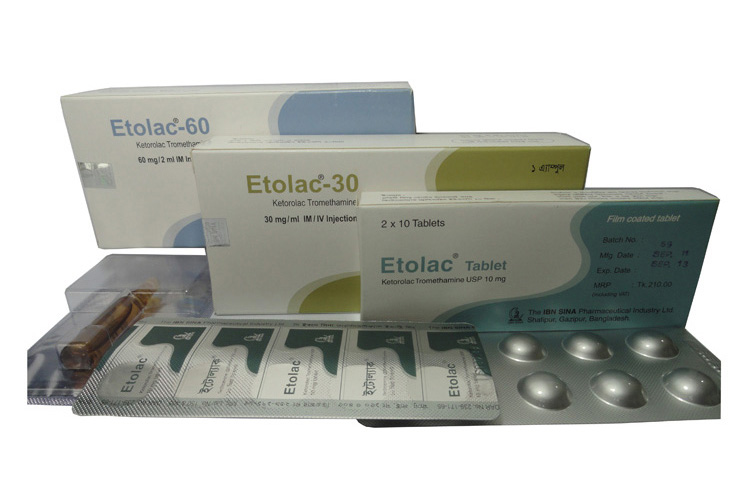
ETOLAC
KETOROLAC TROMETHAMINE
| NAME | STRENGTH | PACK SIZE | DOSAGE FORM |
|---|---|---|---|
| ETOLAC 10MG | 10MG | 20 S | TABLET |
| ETOLAC 30MG/ML | 30MG/ML | 1 S | INJECTION |
| ETOLAC 60MG/2 ML | 60MG/2 ML | 1 S | INJECTION |
Etolac Tablet: Each tablet contains Ketorolac Tromethamine USP 10 mg. Etolac Injection: Each ampoule contains Ketorolac Tromethamine USP 10 mg. Etolac 30 Injection: Each ampoule contains Ketorolac Tromethamine USP 30 mg. Etolac 60 Injection: Each ampoule contains Ketorolac Tromethamine USP 60 mg.
Etolac contains Ketorolac Tromethamine which is a member of the pyrrolopyrrole group of non-steroidal anti-inflammatory drug (NSAID) that exhibits analgesic, anti-inflammatory and antipyretic activity. It inhibits the cyclo-oxygenase enzyme system and hence prostaglandin synthesis. It has more pronounced analgesic activity than most NSAIDs.
Etolac is indicated in short-term management of moderate to severe pain such as acute pain, renal colic, cancer pain, postoperative pain, traumatic pain, musculoskeletal pain and dental pain.
Carefully consider the potential benefits and risks of TORADOL and other
treatment options before deciding to use TORADOL. Use the lowest effective dose
for the shortest duration consistent with individual patient treatment goals. In
adults, the combined duration of use of IV or IM dosing of ketorolac tromethamine
and TORADOLORAL is not to exceed 5 days. In adults, the use of TORADOLORAL is
only indicated as continuation therapy to IV or IM dosing of ketorolac
tromethamine. Transition from IV or IM dosing of ketorolac tromethamine (single- or multipledose) to multiple-dose TORADOLORAL:
Patients age 17 to 64: 20 mg PO once followed by 10 mg q4-6 hours prn not >40 mg/day
Patients age ¿65, renally impaired, and/or weight <50 kg (110 lbs): 10 mg PO once
followed by 10 mg q4-6 hours prn not >40 mg/day
Moderate or severe renal impairment (serum creatinine> 180 micromol/L). A history of haemorrhagic diatheses, including coagulation disorders. Patients on full anticoagulation therapy. Patients who have had operations with a high risk of haemorrhage or incomplete haemostasis. A hypersensitivity to Ketorolac Tromethamine or other NSAIDs and those patients In whom aspirin or other prostaglandin synthetase inhibitors induce allergic reactions. Individuals with the complete or partial syndrome of nasal polyps, angioedema or bronchospasm. A history of asthma. Patients with a prior history of Stevens-Johnson syndrome or vesicular bullous rash. Suspected or confirmed cerebrovascular (intracranial) bleeding. A history of gastrointestinal ulcer and/or bleeding. Prophylactic administration before major surgery or intraoperatively when haemoetasis is critical because of the increased risk of bleeding.
-If patients are Allergic to other anti-inflammatory drugs. Be careful not to splash the mouthwash in eyes. If patients get it in their eyes accidentally, wash them immediately with cold water.
Cardiovascular/haematological: Flushing, bradycardia, pallor, purpura, thrombocytopenia, hypertension, inhibition of platelet aggregation & prolonged bleeding time, postoperative wound haemorrhage and haematoma. Dermatological : Rash or pruritus. Less frequently, Lyell's syndrome, StevensJohnson syndrome, maculo-papular rash, exfoliative dermatitis, or urticaria. Gastrointestinal: Nausea, dyspepsia, GI pain, constipation, diarrhea, flatulence, gastrointestinal fullness, vomiting or stomatitis. Less frequently, peptic ulceration, gastrointestinal hemorrhage, gastrointestinal perforation, melena, rectal bleeding, gastritis, eructation, anorexia, or increased appetite. Very rarely, pancreatitis. Neurological: Drowsiness, dizziness, headache, sweating, injection site pain. Less frequently convulsions, vertigo, tremors, abnormal dreams, hallucinations, or euphoria. Very rarely, paresthesia, depression, insomnia, inability to concentrate nervousness, excessive thirst, dry mouth, abnormal thinking, hyperkinesis, or stupor. Respiratory: Less frequently, dyspnea, asthma and pulmonery edema. Very rarely, rhinitis or cough. Renal: Increased urinary frequency, oliguria, acute renal failure, hyponatraemia, hyperkalaemia, haemolytic uraemic syndrome, flank pain (with or without haematuria), raised serum urea, creatinine and urinary symptoms & acute renal failure. Other: Edema. Less frequently, hypersensitivity reactions (such as anaphylaxis, bronchospasm, laryngeal edema, tongue edema, hypotension), flushing, weight gain, or fever. Very rarely asthenia.
It is detected in human milk. Safety in pregnancy has not been established. It is not recommended during pregnancy, labour or delivery and in mothers who are breast-feeding.
undefined
Ketorolac Tromethamine should not be used with other NSAIDs or in patients receiving aspirin because of the potential for additive side-effects. Care should be taken when administering Ketorolac Tromethamine with anticoagulants since co-administration may cause an enhanced anticoagulant effect. Ketorolac Tromethamine and other NSAIDs can reduce the anti-hypertensive effect of beta-blockers and may increase the risk of renal impairment when administered concurrently, since. some prostaglandin synthesis inhibiting drugs have been reported to reduce the clearance of methotrexate, and thus possibly enhance its toxicity. Probenecid should not be administered concurrently with Ketorolac Tromethamine because of increases in Ketorolac plasma level and half-life.
Symptoms and Signs Symptoms following acute NSAID overdoses are usually limited to lethargy, drowsiness, nausea, vomiting, and epigastric pain, which are generally reversible with supportive care. Gastrointestinal bleeding can occur. Hypertension, acute renal failure, respiratory depression and coma may occur, but are rare. Anaphylactoid reactions have been reported with therapeutic ingestion of NSAIDs, and may occur following an overdose. Treatment Patients should be managed by symptomatic and supportive care following a NSAIDs overdose. There are no specific antidotes. Emesis and/or activated charcoal (60 g to 100 g in adults, 1 g/kg to 2 g/kg in children) and/or osmotic cathartic may be indicated in patients seen within 4 hours of ingestion with symptoms or following a large oral overdose (5 to 10 times the usual dose). Forced diuresis, alkalization of urine, hemodialysis or hemoperfusion may not be useful due to high protein binding. Single overdoses of TORADOL have been variously associated with abdominal pain, nausea, vomiting, hyperventilation, peptic ulcers and/or erosive gastritis and renal dysfunction which have resolved after discontinuation of dosing.
Store in a cool (below 30° C) & dry place, protected from light. Keep out of reach of children.
Elotac Tablet : Each box contains 2 x 10's tablet in Alu-Alu blister strip. Etolac 30 Injection : Each box contains 1's ampoules. Etolac 60 Injection : Each box contains 1 ampoules.
